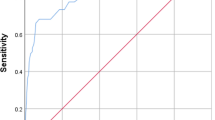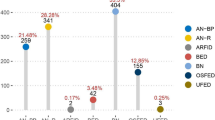Abstract
Background
The Emotional Eating Scale - Adapted for Children and Adolescents (EES-C) assesses children’s urge to eat in response to experiences of negative affect. Prior psychometric studies have demonstrated the high reliability, concurrent validity, and test–retest reliability of theoretically defined subconstructs among non-clinical samples of children and adolescents who were primarily healthy weight; however, no psychometric studies exist investigating the EES-C among clinical samples of children with overweight/obesity (OW/OB). Furthermore, studies conducted in different contexts have suggested a discordant number of subconstructs of emotions related to eating. The purpose of this study was to evaluate the validity of the EES-C in a clinical sample of children seeking weight-loss treatment.
Method
Using a hierarchical bi-factor approach, we evaluated the validity of the EES-C to measure a single general construct, a set of two separate correlated subconstructs, or a hierarchical arrangement of two constructs, and determined reliability in a clinical sample of treatment-seeking children with OW/OB aged 8–12 years (N = 147, mean age = 10.4 years.; mean BMI z = 2.0; female = 66%; Hispanic = 32%, White and other = 68%).
Results
Comparison of factor-extraction methods suggested a single primary construct underlying EES-C in this clinical sample. The bi-factor indices provided clear evidence that most of the reliable variance in the total score (90.8 for bi-factor model with three grouping factors and 95.2 for bi-factor model with five grouping factors) was attributed to the general construct. After adjusting for relationships with the primary construct, remaining correlations among sets of items did not suggest additional reliable constructs.
Conclusion
Results suggest that the primary interpretive emphasis of the EES-C among treatment-seeking children with overweight or obesity should be placed on a single general construct, not on the 3- or 5- subconstructs as was previously suggested.
This is a preview of subscription content, access via your institution
Access options
Subscribe to this journal
Receive 12 print issues and online access
$259.00 per year
only $21.58 per issue
Buy this article
- Purchase on Springer Link
- Instant access to full article PDF
Prices may be subject to local taxes which are calculated during checkout

Similar content being viewed by others
References
Arnow B, Kenardy J, Agras WS. The Emotional Eating Scale: The development of a measure to assess coping with negative affect by eating. Int J Eat Disord. 1995;18:79–90.
Tanofsky‐Kraff M, Theim KR, Yanovski SZ, Bassett AM, Burns NP, Ranzenhofer LM, et al. Validation of the emotional eating scale adapted for use in children and adolescents (EES‐C). Int J Eat Disord. 2007;40:232–40.
Perpiñá C, Cebolla A, Botella C, Lurbe E, Torró M-I. Emotional eating scale for children and adolescents: psychometric characteristics in a Spanish sample. J Clin Child Adolesc Psychol. 2011;40:424–33.
Vannucci A, Tanofsky-Kraff M, Shomaker LB, Ranzenhofer LM, Matheson BE, Cassidy OL, et al. Construct validity of the emotional eating scale adapted for children and adolescents. Int J Obes. 2012;36:938.
Bektas M, Bektas I, Selekoğlu Y, Kudubes AA, Altan SS, Ayar D. Psychometric properties of the Turkish version of the Emotional Eating Scale for children and adolescents. Eat Behav. 2016;22:217–21.
Reise SP. The rediscovery of bifactor measurement models. Multivariate Behav Res. 2012;47:667–96.
Reise SP, Moore TM, Haviland MG. Bifactor models and rotations: exploring the extent to which multidimensional data yield univocal scale scores. J Pers Assess. 2010;92:544–59.
Reise SP, Morizot J, Hays RD. The role of the bifactor model in resolving dimensionality issues in health outcomes measures. Qual Life Res. 2007;16:19–31.
Rodriguez A, Reise SP, Haviland MG. Applying bifactor statistical indices in the evaluation of psychological measures. J Pers Assess. 2016;98:223–37.
Boutelle KN, Braden A, Douglas JM, Rhee KE, Strong D, Rock CL, et al. Design of the FRESH study: a randomized controlled trial of a parent-only and parent–child family-based treatment for childhood obesity. Contemp Clin Trials. 2015;45:364–70.
Boutelle KN, Rhee KE, Liang J, Braden A, Douglas J, Strong D, et al. Effect of attendance of the child on body weight, energy intake, and physical activity in childhood obesity treatment: a randomized clinical trial. JAMA Pediatr. 2017;171:622–8.
Fairburn C, Cooper Z, O’Connor M. Eating disorders examination (16.0 D). Cognitive behavior therapy and eating disorders. New York: Guilford Press; 2008.
Stojek MM, Tanofsky‐Kraff M, Shomaker LB, Kelly NR, Thompson KA, Mehari RD, et al. Associations of adolescent emotional and loss of control eating with 1‐year changes in disordered eating, weight, and adiposity. Int J Eat Disord. 2017;50:551–60.
Achenbach T. Manual for the child behavior checklist/4-18 and 1991 profile. Burlington (VT): University of Vermont, Department of Psychiatry; 1991.
Dutra L, Campbell L, Western D. Quantifying clinical judgment in the assessment of adolescent psychopathology: Reliability, validity, and factor structure of the Child Behavior Checklist for clinician report. J Clin Psychol. 2004;60:65–85.
Team R. R: A language and environment for statistical computing. 2014. (R Foundation for Statistical Computing, Vienna, Austria, 2013).
Statistic I. SPSS 23.0 for windows (Chicago, IL, 2015).
Ruscio J, Roche B. Determining the number of factors to retain in an exploratory factor analysis using comparison data of known factorial structure. Psychol Assess. 2012;242:282–92.
Kaiser H. The application of electronic computers to factor analysis. Educ Psychol Meas. 1960;20:141–51.
Velicer W. Determining the number of components from the matrix of partial correlations. Psychometrika. 1976;41:321–7.
Ledesma R, Valero-Mora P. Determining the number of factors to retain in EFA: An easy-to-use computer program for carrying out parallel analysis. Pract Assess Res Eval. 2007;12:1–11.
Raiche G, Walls T, Jagis D, Riopel M, Blais J-G. Non-graphical solutions for Cattell’s scree test. Methodology. 2013;9:23–9.
Revelle W, Rocklin T. Very simple structure: an alternative procedure for estimating the optimal number of interpretable factors. Multivar Behav Res. 1979;14:403–14.
Hancock GR, Mueller RO. Rethinking construct reliability within latent variable systems. Structural equation modeling: Present and future. Lincolnwood, IL: Scientific Software International Inc.; 2001. p. 195–216.
Bonifay WE, Reise SP, Scheines R, Meijer RR. When are multidimensional data unidimensional enough for structural equation modeling? An evaluation of the DETECT multidimensionality index. Struct Equ Model Multidiscip Jl. 2015;22:504–16.
Cortina JM. What is coefficient alpha? An examination of theory and applications. J Appl Psychol. 1993;78:98.
McDonald RP. Test theory: A unified treatment, Psychology Press, 2013.
Bentler PM. Covariance structure models for maximal reliability of unit-weighted composites. Handbook of latent variable and related models. Vol. 1. Amsterdam, The Netherlands: Elsevier; 2007.
Bentler PM. Alpha, dimension-free, and model-based internal consistency reliability. Psychometrika. 2009;74:137.
Kelley K, Pornprasertmanit S. Confidence intervals for population reliability coefficients: evaluation of methods, recommendations, and software for composite measures. Psychol Methods. 2016;21:69.
Devellis R. Scale development: theory and applications. 2nd Edition (Applied Social Research Methods). Thousand Oaks, CA: Sage Publications, Inc; 2003.
Lindquist K, Barrett L. Emotional complexity. Chapter. In: Lewis M, Haviland-Jones JM, Barrett LF, editors. New York: Guilford; 2008. p. 513–430.
Lane RD, Schwartz GE. Levels of emotional awareness: a cognitive-developmental theory and its application to psychopathology. Am J Psychiatry. 1987;144:133–43.
Flora DB, Curran PJ. An empirical evaluation of alternative methods of estimation for confirmatory factor analysis with ordinal data. Psychol Methods. 2004;9:466.
Crutzen R, Peters G-JY. Scale quality: alpha is an inadequate estimate and factor-analytic evidence is needed first of all. Health Psychol Rev. 2017;11:242–7.
McNeish D. Thanks coefficient Alpha, we’ll take it from here. 2017.
Acknowledgements
This work was supported by the National Institute of Health [grant numbers R01DK075861 and K02HL1120242, PI: Boutelle, K23DK114480, PI: Eichen]. The opinions and assertions expressed herein are those of the authors and are not to be construed as reflecting the views of the National Institute of Health, Uniformed Services University or the U.S. Department of Defense.
Author information
Authors and Affiliations
Corresponding author
Ethics declarations
Conflict of interest
The authors declare that they have no conflict of interest.
Additional information
Publisher’s note: Springer Nature remains neutral with regard to jurisdictional claims in published maps and institutional affiliations.
Rights and permissions
About this article
Cite this article
Kang Sim, D.E., Strong, D.R., Manzano, M. et al. Evaluating psychometric properties of the Emotional Eating Scale Adapted for Children and Adolescents (EES-C) in a clinical sample of children seeking treatment for obesity: a case for the unidimensional model. Int J Obes 43, 2565–2572 (2019). https://doi.org/10.1038/s41366-019-0427-8
Received:
Revised:
Accepted:
Published:
Issue Date:
DOI: https://doi.org/10.1038/s41366-019-0427-8
This article is cited by
-
Associations among alexithymia, disordered eating, and depressive symptoms in treatment-seeking adolescent military dependents at risk for adult binge-eating disorder and obesity
Eating and Weight Disorders - Studies on Anorexia, Bulimia and Obesity (2022)



